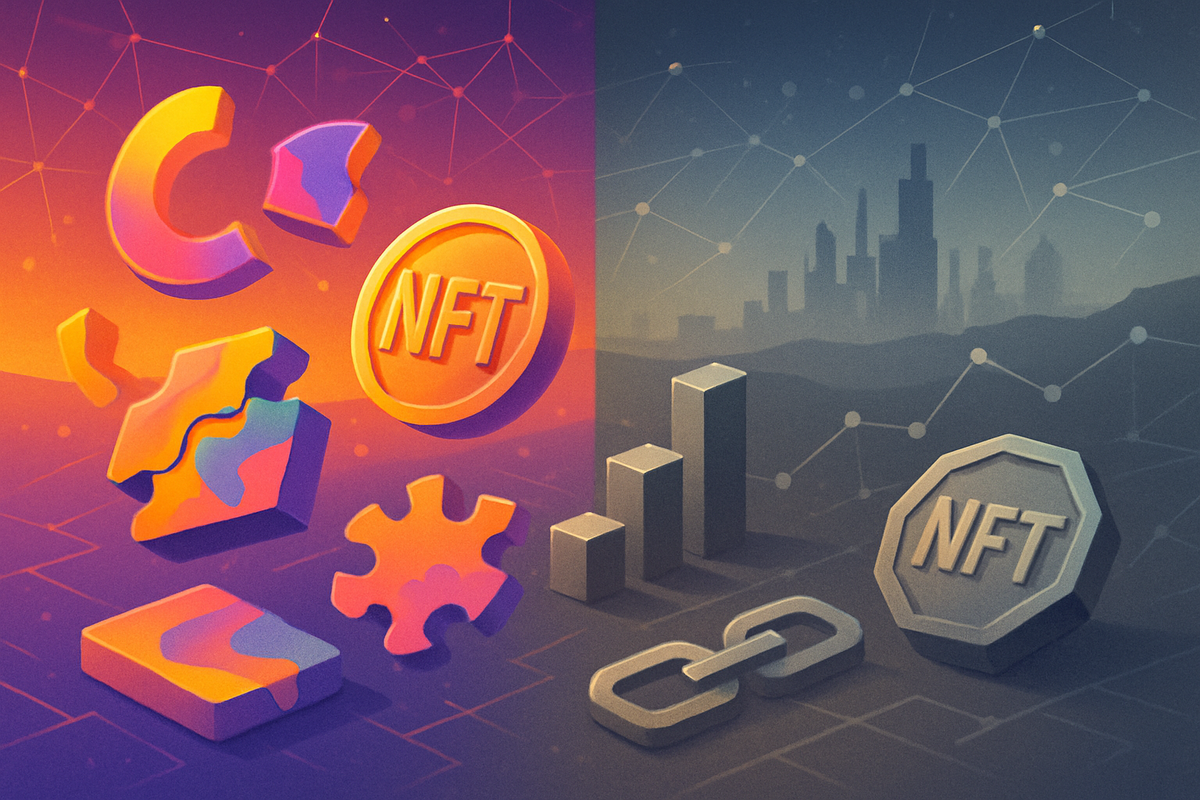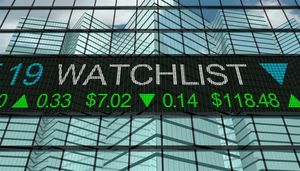
The Non-Fungible Token (NFT) market, once a glittering beacon of digital innovation and speculative wealth, finds itself in a profound state of recalibration as of October 2025. What began as a meteoric rise, fueled by celebrity endorsements and unprecedented hype, has largely given way to a sobering reality where many investors are counting significant losses. The initial gold rush mentality, where digital JPEGs commanded millions, has dissipated, replaced by a cautious, often skeptical, sentiment as the market grapples with maturity, utility, and the harsh realities of speculative bubbles.
MarketMinute's analysis reveals a sector attempting to pivot from pure speculation to tangible utility, yet still reeling from a dramatic contraction. While overall market capitalization shows some resilience, trading volumes have plummeted from their 2021-2022 peaks, and revenue projections for 2025 indicate a significant decline. This downturn is largely attributed to fading speculative hype, a strong correlation with volatile cryptocurrency prices, dwindling retail interest, and the inherent illiquidity of many NFT assets, leaving countless early adopters trapped in holdings now deemed "essentially worthless."
The Meteoric Rise and Precipitous Fall of Digital Collectibles
The genesis of NFTs can be traced back to the niche corners of the blockchain world in the mid-2010s, with early projects like CryptoPunks (Ethereum) (Larva Labs) in 2017 laying the groundwork for digital ownership. However, it was the phenomenon of CryptoKitties (Ethereum) in late 2017 that first demonstrated the mainstream appeal and potential for digital collectibles, causing significant network congestion and sparking early interest in platforms like OpenSea (Ethereum). The market steadily grew, with 2020 seeing a 299% surge in transaction value, but the true explosion occurred in 2021. This year marked the "NFT Summer," propelled by digital artist Beeple's historic sale of "Everydays: The First 5000 Days" for a staggering $69 million at Christie's in March, catapulting NFTs into global headlines and attracting a wave of new investors and creators.
The boom intensified with the emergence of iconic collections such as Bored Ape Yacht Club (Ethereum) (Yuga Labs), launched in April 2021, which quickly became a cultural touchstone and a status symbol for celebrities and early adopters. Other major players included Axie Infinity (Ethereum), pioneering the play-to-earn gaming model, and NBA Top Shot (Flow) (Dapper Labs), offering licensed digital sports moments. Marketplaces like OpenSea (Ethereum) dominated trading, handling billions in volume, while platforms like Rarible (Ethereum) and Foundation (Ethereum) also saw significant activity. Celebrities played a crucial role in amplifying the hype, with figures like Snoop Dogg, Paris Hilton, Justin Bieber, and Mila Kunis either purchasing high-value NFTs, launching their own collections, or openly endorsing the technology, further fueling the speculative frenzy. January 2022 marked the peak, with a record $17.2 billion in monthly sales volume.
However, the euphoria was short-lived. By early 2022, the market began a sharp decline, turning into a "long winter" by Q2 2025. This precipitous fall was driven by a confluence of factors: market saturation with countless low-quality projects, the inevitable bursting of a speculative bubble where prices became detached from intrinsic value, and a broader economic downturn that shifted investor focus away from risky assets. Furthermore, the inherent lack of real-world utility for many NFTs, coupled with rampant scams, fraud, and ongoing regulatory uncertainty, eroded investor confidence. High transaction costs on popular blockchains and environmental concerns also contributed to the exodus. The once-dominant OpenSea (Ethereum) saw its daily trading volumes shrink from $200 million daily peaks to under $5 million by May 2025, a stark indicator of the market's contraction. The shift in market dynamics moved from a focus on quick profits and PFP collections to a demand for utility, real-world applications, and more robust, sustainable projects.
Navigating the New NFT Landscape: Winners and Losers Emerge
The dramatic shift in the NFT market from speculative fervor to a demand for tangible utility has profoundly impacted companies operating within this ecosystem, creating clear winners and those facing significant headwinds. Marketplaces, once solely focused on high-volume PFP sales, are now adapting to a more discerning user base. OpenSea (Private), the former titan of NFT trading, is aggressively pivoting to become a multi-asset on-chain trading portal, launching its native token (SEA) and expanding support across 19 blockchains to incentivize engagement. While this demonstrates a proactive strategy, its mixed outlook reflects the challenge of reclaiming dominance amidst fierce competition from platforms like Blur (Private), which has successfully captured professional traders with its reward-based incentives and lower fees, and Magic Eden (Private), which continues to thrive on the Solana (SOL) blockchain due to its efficiency and lower transaction costs.
Game developers and luxury brands are proving to be fertile ground for utility-driven NFTs. Animoca Brands (Private), a powerhouse in blockchain gaming and Web3 investment, is strategically diversifying its portfolio beyond just game development into advisory services and AI, reporting substantial growth in 2024. This broad investment and focus on digital property rights position it strongly. Similarly, Yuga Labs (Private), the creator of Bored Ape Yacht Club (Ethereum), is undergoing a significant restructuring, with co-founder Greg Solano returning as CEO to refocus on its Otherside (Ethereum) metaverse and deliver tangible utility to its token holders. Their success hinges on effective execution of this ambitious metaverse vision. In the luxury sector, brands like Louis Vuitton (LVMH:PA) and Gucci (KER:PA) are clear winners, leveraging NFTs for exclusive "phygital" products, enhancing customer engagement, and combating counterfeits through initiatives like Louis Vuitton's "Via" NFT project and Gucci's "Gucci Vault." Nike (NKE:NYSE), despite winding down its RTFKT acquisition, is strategically integrating Web3 elements directly into its core brand through platforms like .SWOOSH, indicating a shift towards direct customer engagement and loyalty.
Underpinning this evolving landscape are the blockchain infrastructure providers. Layer-2 solutions like Immutable X (Private) and Polygon Labs (Private) (oversees Polygon blockchain) are emerging as critical enablers, particularly for gaming NFTs. Immutable X's focus on scalable, cost-effective infrastructure for gaming has led to a 25% annual increase in active wallets linked to gaming NFTs. Polygon's affordability and speed make it attractive for high-transaction-volume applications. Similarly, the Solana (SOL) blockchain continues to gain traction for its fast transaction speeds and lower fees, becoming a preferred platform for developers building utility-focused NFTs. These infrastructure providers are essential for the long-term health and expansion of the utility-driven NFT market, facilitating the shift away from speculative assets towards functional digital tools and experiences.
Beyond the Hype: NFTs' Enduring Impact and Regulatory Realities
The tumultuous journey of the NFT market, from a speculative frenzy to a more discerning landscape, holds profound wider significance for the burgeoning Web3 and digital economy. At its core, NFTs are foundational to the Web3 ethos, enabling true digital ownership and empowering creators by providing verifiable proof of authenticity and allowing for new monetization models, including direct sales and automated royalties. They are the "silent engines" driving metaverse economies, representing everything from virtual real estate to in-game assets, and are increasingly integrating with decentralized finance (DeFi) and the tokenization of real-world assets (RWAs). This shift towards utility-driven NFTs signifies a maturation, moving beyond mere collectibles to becoming integral components of a decentralized digital future.
The ripple effects of this evolution are reshaping traditional industries. In the art world, NFTs have democratized access, allowing artists to bypass traditional gatekeepers and directly monetize digital creations, while also introducing new forms like generative and interactive art. The gaming industry is undergoing a paradigm shift with "Play-to-Earn" models and true ownership of in-game assets, fostering new player economies and potential interoperability across different virtual worlds. Financial services are also being transformed, with NFTs enabling fractional ownership of real estate and other securities, enhancing liquidity, and streamlining trading processes through tokenization. This creates entirely new asset classes and financial products, pushing the boundaries of traditional finance.
As of October 2025, the regulatory landscape for NFTs is finally gaining some much-needed clarity, particularly in the United States. A pivotal U.S. federal court ruling recently dismissed a class-action lawsuit against Yuga Labs (Private) regarding Bored Ape Yacht Club (Ethereum) NFTs and ApeCoin, asserting that these assets do not qualify as securities under the Howey Test. This decision provides a crucial precedent, narrowing the scope of SEC enforcement for digital collectibles marketed with access-based perks rather than as speculative financial instruments. Furthermore, reports indicate a potential reclassification of meme coins and NFTs as "collectibles" under the Trump administration, shifting oversight from the SEC to the Commodity Futures Trading Commission (CFTC). While this move towards principles-based regulation is seen as a catalyst for innovation, challenges persist, including market illiquidity, metadata centralization risks, and ongoing global regulatory fragmentation, alongside potential tax implications for collectibles.
The NFT market's boom and bust cycle draws striking parallels to historical asset bubbles, most notably the dot-com bubble of the late 1990s. Both periods were characterized by intense speculative hype, overconfidence, and investments driven by the promise of rapid gains, often detached from underlying fundamentals, leading to exponential growth followed by a sharp correction. However, a key distinction lies in the current emphasis on utility. Unlike many dot-com ventures that lacked viable business models, the evolving NFT market is increasingly focused on practical applications across diverse industries. While still susceptible to volatility, this pivot towards tangible use cases suggests a potential for long-term value creation that extends beyond pure speculation, marking a critical phase in its development.
The Road Ahead: A Mature, Utility-Driven Future for NFTs
As of October 2025, the NFT market is charting a course towards a more mature and utility-driven future, moving decisively beyond the speculative excesses of its early boom. In the short term, the market is solidifying its pivot towards practical applications, with a notable increase in the number of transactions, even as overall trading volumes have tempered. The global NFT market is projected to reach approximately $61 billion this year, buoyed by continuous infrastructure improvements like more efficient Layer 2 solutions and heightened competition among alternative Layer 1 blockchains, which collectively reduce transaction fees and enhance user experience. The recent rally in Bitcoin, nearing $115,000, has also injected renewed enthusiasm and investor interest into the broader crypto and NFT ecosystem.
Looking further ahead, the long-term outlook for NFTs is one of dramatic expansion. Projections suggest the global NFT market could soar to between $211.7 billion and $247 billion by 2030, potentially reaching $703.47 billion by 2034. NFTs are increasingly recognized as an indispensable component of the Web3 infrastructure, poised to fundamentally redefine digital ownership and intellectual property rights. They are seen as a crucial gateway for mainstream crypto adoption, attracting millions through engaging and practical applications that extend far beyond simple digital collectibles.
This evolving landscape presents significant market opportunities and strategic pivots. Web3 gaming and the metaverse are emerging as major catalysts, with "Play-to-Earn" and "Play-to-Own" models empowering players with true ownership of in-game assets and fostering new virtual economies. The virtual real estate market, where NFTs represent property deeds, is also projected for substantial growth. Perhaps the most disruptive trend is Real-World Asset (RWA) tokenization, where NFTs are used to tokenize physical assets like real estate, art, and luxury goods, enabling fractional ownership, enhancing liquidity, and reducing fraud. This market is projected to hit $50 billion in 2025, signaling its deep integration into mainstream finance. Additionally, NFTs are finding applications in digital identity, AI-generated content, event ticketing, supply chain transparency, and customer loyalty programs.
Despite the optimistic trajectory, challenges remain. Technical knowledge requirements, high costs (though improving), market saturation, and security concerns continue to be hurdles for creators. While regulatory clarity is emerging, especially in the U.S., global inconsistencies and the inherent volatility linked to broader cryptocurrency prices still pose risks. However, ongoing innovations promise to address these challenges. Improved blockchain infrastructure, cross-chain interoperability, advanced AI integration for dynamic content and automation, and the development of dynamic and hybrid NFTs, along with fractionalization, are all on the horizon. These advancements, coupled with clearer regulatory frameworks, are set to foster a more secure, legitimate, and accessible NFT market, attracting both retail and institutional investors. The likely scenario is a "maturation" of the ecosystem, driven by innovation, institutional adoption, and a relentless focus on real-world utility.
The Enduring Evolution: A New Era for Digital Ownership
The journey of the NFT market has been a spectacular, albeit turbulent, ride. From the dizzying heights of its speculative boom in 2021-2022, fueled by digital art and PFP collections commanding exorbitant prices, to the sobering market correction of 2023-2024, the sector has shed its initial froth. The key takeaway from this journey is a profound and irreversible pivot: from pure speculation and aesthetic appeal to a demand for practical applications and tangible utility. The "NFT Summer" may be a distant memory, but the underlying technology is now recognized as a legitimate digital asset class with diverse functionalities, moving beyond fleeting trends to become a foundational component of the digital economy.
As of October 2025, the NFT market is in a crucial phase of maturation. While overall trading volumes have tempered, the sheer number of transactions is on an upward trajectory, indicating broader adoption. The market is projected to reach approximately $61 billion this year, driven by the dominance of utility-driven NFTs, particularly in gaming, real-world asset (RWA) tokenization, and integrations with decentralized finance (DeFi). Technological advancements, including more efficient Layer 2 solutions and alternative Layer 1 blockchains, are enhancing accessibility and reducing costs. Crucially, recent regulatory clarity in the U.S., such as the dismissal of the Yuga Labs (Private) lawsuit and the potential reclassification of some NFTs as "collectibles," is providing much-needed legitimacy and easing investor apprehension.
Looking ahead, the future trajectory promises significant growth, with projections soaring into the hundreds of billions by 2030 and beyond. NFTs are poised to become the "silent engines of the digital economy," enabling stronger digital rights, streamlining systems, and unlocking novel opportunities across gaming, real estate, music, fashion, identity, and supply chain management. This enduring impact will redefine our perception of digital ownership, empower creators, foster new forms of community engagement, and bridge the gap between digital and physical realms. The "gold rush" is over; the market has entered a "real building phase" where sustainable projects with genuine utility will thrive.
For investors navigating this evolving landscape, a strategic and cautious approach is paramount. Prioritize utility and value over speculative hype, focusing on projects that offer clear, tangible benefits. Conduct thorough due diligence on the team, roadmap, community, and smart contracts. Understand your risk profile and allocate only a small, diversified percentage of your portfolio, as NFTs remain high-risk, low-liquidity investments. Stay informed on regulatory developments and monitor technological innovations like Layer 2s, cross-chain interoperability, and AI integration. Finally, consider the environmental sustainability of projects. The market is no longer about quick flips but about identifying robust, long-term value propositions in a rapidly maturing ecosystem.
This content is intended for informational purposes only and is not financial advice





